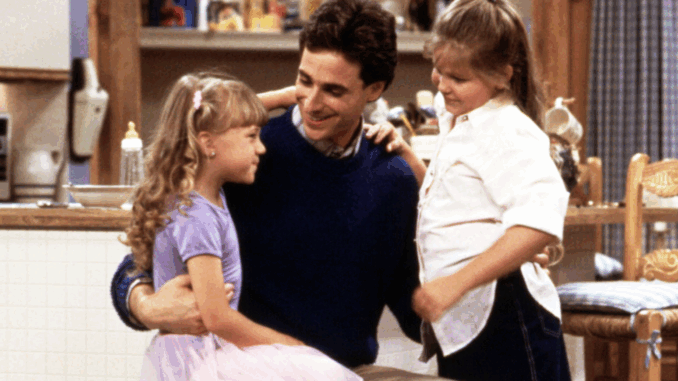
When Full House premiered in 1987, few could predict it would become a cornerstone of family television and a lasting pop culture icon. The show’s unique blend of humor, heartfelt family moments, and wholesome values helped redefine the TV sitcom landscape. Over three decades later, Full House still influences how family sitcoms are made and loved, proving that the Tanner family’s story is more than just a TV show—it’s a cultural phenomenon. Let’s explore how Full House made such a massive impact on pop culture and television.
Revolutionizing the Family Sitcom Genre
Before Full House, many family sitcoms focused on traditional nuclear families or used sitcom tropes that didn’t always emphasize emotional depth. Full House broke new ground with its portrayal of an unconventional family led by a single dad raising his three daughters with help from close friends.
Introducing Non-Traditional Families
The show was one of the first mainstream sitcoms to highlight a non-traditional family structure, showcasing the idea that family is about love and support, not just biology. This opened doors for future shows to explore diverse family setups.
Balancing Humor and Heart
Full House struck the perfect balance between comedy and emotional moments. Episodes mixed laughter with life lessons—whether about honesty, responsibility, or kindness—making the show relatable to viewers of all ages.
Iconic Characters That Shaped Pop Culture
From the responsible Danny Tanner to the cool Uncle Jesse, every character in Full House left a mark on pop culture.
Catchphrases and Quirks
Joey’s “Cut-it-out!” and Stephanie’s “How rude!” became household phrases. These catchphrases helped cement the characters in fans’ hearts and everyday language.
The Tanner Kids as Role Models
D.J., Stephanie, and Michelle were more than cute kids on TV—they represented various stages of childhood and adolescence, inspiring generations of young viewers.
Influence on Future TV Sitcoms
Full House set a new standard for family sitcoms that followed.
The Template for Family Shows
Shows like Boy Meets World, Home Improvement, and The Middle borrowed from Full House’s formula of mixing comedy with heartfelt family moments.
Opening the Door for Spin-Offs and Sequels
The success of Full House paved the way for Fuller House decades later, proving that beloved family sitcoms can thrive with modern updates.
Full House and the Rise of Nostalgia TV
The show’s revival with Fuller House tapped into the massive power of nostalgia.
Connecting Generations
Fuller House brought together original fans and new viewers, proving that the Tanner family’s appeal spans ages.
Nostalgia as a Cultural Force
Full House showed how TV shows can become cultural touchstones that people return to for comfort, humor, and timeless values.
Merchandising and Pop Culture Presence
Beyond the screen, Full House influenced fashion, toys, and media.
Iconic Outfits and Style
Jesse’s leather jackets and Kimmy’s quirky clothes became iconic looks replicated by fans.
Merchandise and Media Spin-Offs
From DVDs to themed parties, Full House’s presence extended into daily life, solidifying its pop culture footprint.
The Show’s Role in Addressing Social Issues
Though light-hearted, Full House tackled important social topics with care.
Lessons on Responsibility and Respect
The show addressed issues like peer pressure, honesty, and loss in ways accessible to kids and adults alike.
Setting a Positive Example
By presenting problems and solutions through a family lens, Full House became a subtle educator in social values.
Fan Communities and Cultural Events
Full House inspired dedicated fan clubs, conventions, and social media groups.
Keeping the Legacy Alive
These communities keep the show’s spirit alive through discussions, fan art, and meet-ups.
Bridging the Gap Between Past and Present
Fan activities create connections between original viewers and newer fans discovering the show.
Conclusion
Full House is much more than a nostalgic sitcom; it’s a cultural cornerstone that reshaped television’s portrayal of family and humor. Its innovative approach to family dynamics, memorable characters, and balance of heart and comedy set a template that still influences sitcoms today. Through its revival and enduring fanbase, the Tanner family continues to impact pop culture, proving that great storytelling—and great values—never go out of style.
Frequently Asked Questions
Q1: How did Full House change the way families are portrayed on TV?
It introduced non-traditional family structures and emphasized love and support over biology.
Q2: What are some iconic catchphrases from Full House?
Joey’s “Cut-it-out!” and Stephanie’s “How rude!” are among the most memorable.
Q3: How did Full House influence later TV sitcoms?
It set a template for blending humor with heartfelt family lessons, influencing many shows after it.
Q4: Why was Fuller House successful?
It tapped into nostalgia while updating the story for a new generation, bridging fans old and new.
Q5: Does Full House address social issues?
Yes, it tackled topics like honesty, responsibility, and family challenges in an accessible way.
